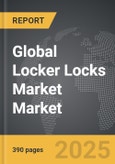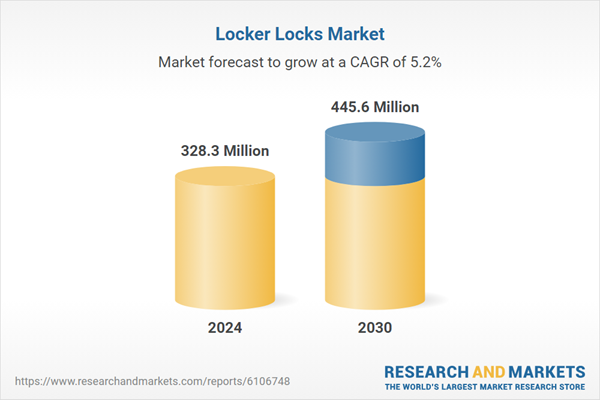Global Locker Locks Market - Key Trends & Drivers Summarized
Why Are Locker Locks Considered Essential in Securing Personal and Commercial Spaces Today?
Locker locks play a critical role in modern security infrastructure, serving as a fundamental solution for safeguarding personal belongings in a wide array of environments such as schools, gyms, workplaces, hospitals, and transportation hubs. As society becomes increasingly mobile and communal spaces more prevalent, the need for reliable and easy-to-use security solutions has grown significantly. Locker locks provide users with peace of mind, ensuring that their valuables are protected in both public and private settings. In educational institutions, locker locks help students secure books, electronics, and personal items, while in gyms and fitness centers, they are essential for safeguarding clothing, wallets, and mobile devices during workouts. Workplaces often rely on locker locks to secure uniforms, laptops, and confidential documents, particularly in manufacturing, healthcare, and logistics sectors. The growing emphasis on safety, privacy, and convenience has made locker locks a standard feature across facilities that serve large, transient populations. Their versatility and cost-effectiveness also make them a preferred choice for both temporary and long-term storage needs. Whether used with mechanical key systems, combination dials, or more advanced digital access controls, locker locks remain one of the most dependable and straightforward ways to prevent theft and unauthorized access. As storage needs evolve with changing work and lifestyle patterns, locker locks continue to play a foundational role in personal security and organizational efficiency.How Are Technological Advancements Reshaping the Design and Functionality of Locker Locks?
The locker lock market is undergoing a significant transformation, fueled by rapid technological innovation that is enhancing both security features and user convenience. Traditional padlocks and mechanical key locks are now being supplemented or replaced by electronic and smart lock systems that offer advanced capabilities such as keyless entry, biometric verification, and mobile app integration. Digital locker locks allow users to unlock compartments using PIN codes, RFID cards, or smartphone connectivity, eliminating the need for physical keys and reducing the risks associated with lost or duplicated access devices. Some of the latest models come with features like audit trails, which log access history to monitor usage and deter misuse, a particularly valuable function in high-security or high-traffic areas. Battery-powered and hardwired options are available, offering flexibility in design and installation. Bluetooth-enabled locks provide remote access control, making them popular in coworking spaces, gyms, and public facilities. Biometric locks, though more expensive, are gaining traction in sensitive environments such as research labs or executive locker rooms, where fingerprint access adds an additional layer of protection. Energy-efficient designs and low-battery alerts are also being incorporated to ensure reliability and minimize maintenance interruptions. These advancements are not only boosting the security profile of locker systems but are also improving the overall user experience, making them more intuitive, responsive, and adaptable to a range of commercial and institutional applications.What Market and Usage Trends Are Influencing the Adoption of Locker Locks Across Different Sectors?
The increasing demand for secure, personal storage solutions in communal and public spaces is significantly influencing the adoption of locker locks across various sectors. In educational institutions, the shift toward digital learning and tech-equipped classrooms has led to a higher need for secure lockers that can safely store laptops, tablets, and other valuable devices. As a result, schools and universities are moving toward combination and digital locker locks that are easier to manage at scale. In fitness centers and sports facilities, user expectations for convenience and hygiene are driving the adoption of keyless and contactless locker systems. The hospitality sector is also embracing high-tech locker locks, particularly in spas, resorts, and entertainment venues, where the guest experience is enhanced by smooth and secure storage access. The corporate world is seeing a rise in demand for employee locker solutions as flexible work arrangements and shared workspaces become more common. With workers rotating between home and office, secure storage for personal items, electronics, and documents becomes essential. In transportation hubs such as airports and train stations, lockers with automated locking systems and multilingual interfaces are gaining popularity among travelers. The retail industry, particularly in e-commerce fulfillment and store pickup models, is incorporating smart locker systems with advanced locking mechanisms for parcel security and customer convenience. These diverse applications underscore a growing recognition of the value locker locks bring in maintaining order, safety, and convenience in dynamic and high-traffic environments.What Key Factors Are Driving the Global Growth of the Locker Locks Market?
The growth in the global locker locks market is being driven by several interrelated factors that span consumer behavior, technology development, infrastructure expansion, and security awareness. One major driver is the rising emphasis on personal security and privacy, particularly in shared and semi-public environments such as educational institutions, gyms, transportation facilities, and office complexes. As users seek more secure and user-friendly storage solutions, the demand for advanced locking systems is growing accordingly. Urbanization and the construction of smart buildings with integrated security systems are further fueling demand for digital locker locks that align with broader automation and smart infrastructure goals. The global boom in fitness and wellness industries is also contributing significantly, with health clubs and recreational centers requiring high-quality locker systems for member retention and operational efficiency. The education sector, especially in developing countries, is seeing increased investment in school infrastructure, including secure locker solutions for students and faculty. Additionally, the rise of parcel locker services and click-and-collect models in retail is generating new commercial applications for electronically controlled locks. Regulatory compliance related to data protection and privacy in workplaces is prompting businesses to invest in secure employee storage solutions. The availability of a wide range of products at different price points, along with modular and customizable designs, is making locker locks accessible to organizations of all sizes. Collectively, these factors are shaping a robust growth trajectory for the locker locks market, supported by rising security needs and an expanding array of use cases in both public and private sectors.Report Scope
The report analyzes the Locker Locks market, presented in terms of market value (US$). The analysis covers the key segments and geographic regions outlined below:- Segments: Type (Electric / Digital / Smart Locks, Cam Locks, Barrel / Cylinder Locks, Coin Return / Coin Deposit Locks, Other Types); Distribution Channel (Online Distribution Channel, Offline Distribution Channel); Application (Education Centers Application, Corporate Offices & Industrial Units Application, Recreational Centers Application, Public Transport Facilities Application, Other Applications).
- Geographic Regions/Countries: World; United States; Canada; Japan; China; Europe (France; Germany; Italy; United Kingdom; Spain; Russia; and Rest of Europe); Asia-Pacific (Australia; India; South Korea; and Rest of Asia-Pacific); Latin America (Argentina; Brazil; Mexico; and Rest of Latin America); Middle East (Iran; Israel; Saudi Arabia; United Arab Emirates; and Rest of Middle East); and Africa.
Key Insights:
- Market Growth: Understand the significant growth trajectory of the Electric / Digital / Smart Locks segment, which is expected to reach US$186.3 Million by 2030 with a CAGR of a 4.6%. The Cam Locks segment is also set to grow at 4.4% CAGR over the analysis period.
- Regional Analysis: Gain insights into the U.S. market, valued at $89.4 Million in 2024, and China, forecasted to grow at an impressive 8.1% CAGR to reach $88.2 Million by 2030. Discover growth trends in other key regions, including Japan, Canada, Germany, and the Asia-Pacific.
Why You Should Buy This Report:
- Detailed Market Analysis: Access a thorough analysis of the Global Locker Locks Market, covering all major geographic regions and market segments.
- Competitive Insights: Get an overview of the competitive landscape, including the market presence of major players across different geographies.
- Future Trends and Drivers: Understand the key trends and drivers shaping the future of the Global Locker Locks Market.
- Actionable Insights: Benefit from actionable insights that can help you identify new revenue opportunities and make strategic business decisions.
Key Questions Answered:
- How is the Global Locker Locks Market expected to evolve by 2030?
- What are the main drivers and restraints affecting the market?
- Which market segments will grow the most over the forecast period?
- How will market shares for different regions and segments change by 2030?
- Who are the leading players in the market, and what are their prospects?
Report Features:
- Comprehensive Market Data: Independent analysis of annual sales and market forecasts in US$ Million from 2024 to 2030.
- In-Depth Regional Analysis: Detailed insights into key markets, including the U.S., China, Japan, Canada, Europe, Asia-Pacific, Latin America, Middle East, and Africa.
- Company Profiles: Coverage of players such as AB Science, Actuate Therapeutics Inc., Amgen Inc., AstraZeneca PLC, Bayer AG and more.
- Complimentary Updates: Receive free report updates for one year to keep you informed of the latest market developments.
Some of the 48 companies featured in this Locker Locks market report include:
- ABUS
- ASSA ABLOY
- Camlock Systems Ltd.
- Codelocks
- Combi-Cam (FJM Security Products)
- Digilock
- dormakaba (KABA)
- ESP (Electronic Security Products)
- Euro-Locks Inc.
- FJM Security Products
- Godrej Locking Solutions and Systems
- Hafele
- Keyless.Co
- Littelfuse
- LockeyUSA
- Lowe & Fletcher
- Master Lock
- Ojmar
- SECURAM Systems
- Zephyr Lock
This edition integrates the latest global trade and economic shifts into comprehensive market analysis. Key updates include:
- Tariff and Trade Impact: Insights into global tariff negotiations across 180+ countries, with analysis of supply chain turbulence, sourcing disruptions, and geographic realignment. Special focus on 2025 as a pivotal year for trade tensions, including updated perspectives on the Trump-era tariffs.
- Adjusted Forecasts and Analytics: Revised global and regional market forecasts through 2030, incorporating tariff effects, economic uncertainty, and structural changes in globalization. Includes historical analysis from 2015 to 2023.
- Strategic Market Dynamics: Evaluation of revised market prospects, regional outlooks, and key economic indicators such as population and urbanization trends.
- Innovation & Technology Trends: Latest developments in product and process innovation, emerging technologies, and key industry drivers shaping the competitive landscape.
- Competitive Intelligence: Updated global market share estimates for 2025, competitive positioning of major players (Strong/Active/Niche/Trivial), and refined focus on leading global brands and core players.
- Expert Insight & Commentary: Strategic analysis from economists, trade experts, and domain specialists to contextualize market shifts and identify emerging opportunities.
Table of Contents
Companies Mentioned (Partial List)
A selection of companies mentioned in this report includes, but is not limited to:
- ABUS
- ASSA ABLOY
- Camlock Systems Ltd.
- Codelocks
- Combi-Cam (FJM Security Products)
- Digilock
- dormakaba (KABA)
- ESP (Electronic Security Products)
- Euro-Locks Inc.
- FJM Security Products
- Godrej Locking Solutions and Systems
- Hafele
- Keyless.Co
- Littelfuse
- LockeyUSA
- Lowe & Fletcher
- Master Lock
- Ojmar
- SECURAM Systems
- Zephyr Lock
Table Information
| Report Attribute | Details |
|---|---|
| No. of Pages | 390 |
| Published | November 2025 |
| Forecast Period | 2024 - 2030 |
| Estimated Market Value ( USD | $ 328.3 Million |
| Forecasted Market Value ( USD | $ 445.6 Million |
| Compound Annual Growth Rate | 5.2% |
| Regions Covered | Global |









